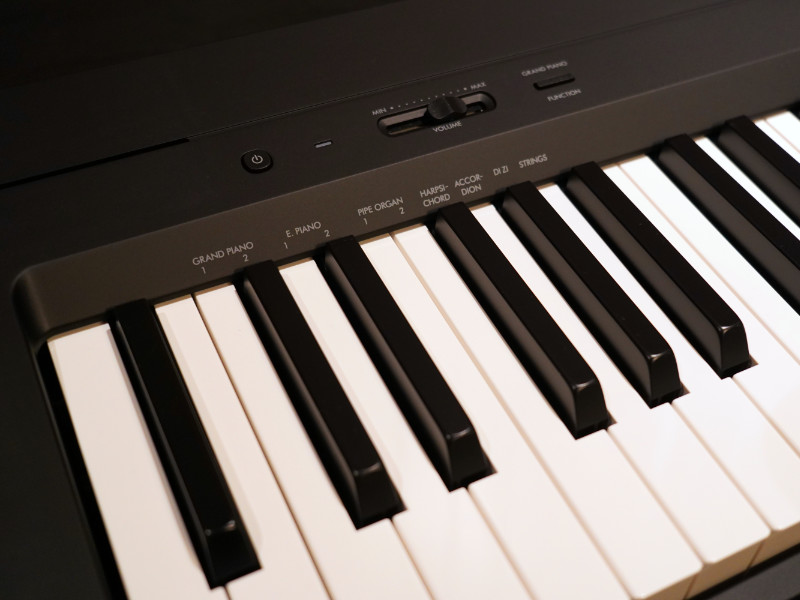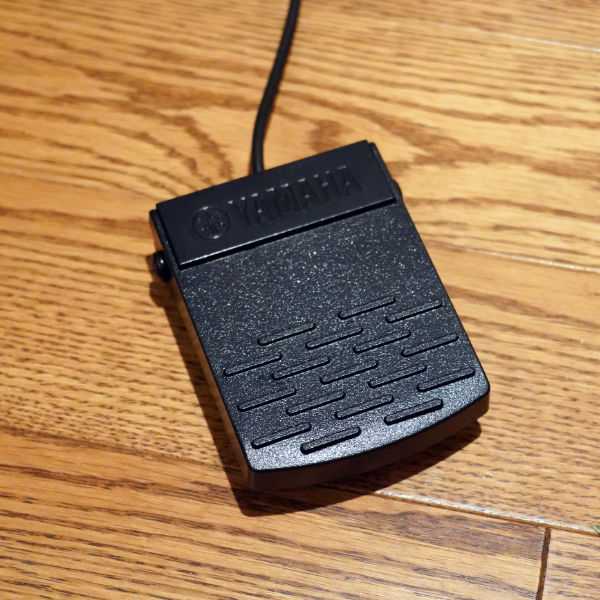
Yamaha has a great reputation amongst musicians of all levels. The Japanese manufacturer has great options for total beginners, as well as reliable models for demanding professionals. The gear is sturdy and is meant to be played for years. The P series has been around for a long time and the company has recently added to this best-selling line. I’ve recently received the Yamaha P-145: a streamlined and portable digital piano. Read on to find out if this model is for you.
First of all, check out this short video I filmed that details some of the features of the P-145 and includes my first impressions and some sound samples.
Yamaha P-145 design and features

The P-145 has a sleek and stylish design. It has been created to be as compact as possible, without sacrificing feel and sound. This kind of model will fit into any décor, no matter the amount of space available. The main panel is devoid of the dozens of buttons you might see on other products. This makes playing the focus and will help beginners concentrate on their technique and the music they are learning.
The two speakers are 7W 12cm x 8cm models. These provide plenty of detail and depth. The volume is sufficient to cover medium to large sized rooms without any trouble. There is also an interesting Sound Boost effect that feels like your piano has a punchier tone to it. It’s ideal if you are playing in a noisy environment or if you feel overpowered by other instruments playing with you.
Great action to learn and play on
Even though the P-145 is very compact, the action on this model is weighed and graded. The newly developed GHC (Graded Hammer Compact) has been designed for the new entries in the P series. The result responds to your intensity appropriately all while remaining light in actual weight.
The fact that the action is graded adds even more realism than simple weight. A graded action will emulate extra resistance in the low register (where the strings in an acoustic piano are thicker) and lower resistance for higher notes. These two features make for an authentic playing experience that beginners will benefit from.
Collection of essential sounds

On board the P-145, there are 10 voices (sounds) to keep you busy and give you some inspiration. First, the main piano tone is based on Yamaha’s well known CFIIIS grand piano. This model is the type of instrument you find in concert halls around the world and played by master players. There is also a second alternative piano sound built in.
Additionally, you’ll have access to 8 more sounds: a pair of electric pianos and pipe organs, a harpsichord, an accordion, a set of strings and a Di Zi, a widespread Chinese flute. You can layer two sounds to create new soundscapes and there are four types of reverb to explore.
Extra connectivity
On the back panel of the P-145 digital piano, you’ll find some interesting connections. First, there is a headphone output, ideal for silent, late-night practice. You can also use it to connect to a mixer or PA system. There are also different jacks for either a single sustain pedal or a 3-pedal unit.

One of the great features on this piano is the USB-to-host. This enables you to connect to a computer or an iOS or Android device. With the former, you’ll be able to record directly into a DAW (there is a built-in 44.1k 16-bit audio interface) or use different sound banks. With the latter, you’ll be able to do the same or make use of Yamaha’s two compatible apps: Smart Pianist and Rec’n’Share. Smart Pianist is a tool that lets you edit your sound and features a learning environment. Rec’n’Share is the best way to film and record yourself playing, using the instrument’s built-in sound.
Accessories
Shipped with the P-145 is a power adapter, music rest, and simple foot pedal for sustaining your notes. There are a few optional accessories to consider too. If you plan on keeping the instrument mainly in your home, take a look at a minimalist piano stand like the L-100 for a more conventional look. Additionally, the LP-5A, a triple pedal unit, would make a perfect companion to the stand.
If you plan on carrying the keyboard to lessons, rehearsals, or even concerts, the SC-KB851 is Yamaha’s own soft carrying case that will fit your piano. Lastly, the UD-BT01 is a Bluetooth MIDI adapter that you can use with your iOS devices or Mac wirelessly.
Playing the Yamaha P-145 digital piano
Playing the P-145 is very enjoyable. The action is responsive, realistic, and a lot of fun to play. Yamaha did an excellent job in recreating the feeling of a true acoustic piano in a digital, compact keyboard. Beginners will have something quite authentic to learn on while experienced players will feel right at home.
All the tones on the keyboard are satisfying. I particularly enjoyed the main tone, especially through my headphones. The speakers have a sort of tinny quality, but get the job done. There is no dedicated speaker output, so you’ll have to make do with the headphone out.
Who is the Yamaha P-145 digital piano for?

The P-145 was designed to give beginners a warm welcome to the instrument. It is a great place to start thanks to wonderful action, great sound quality and excellent reliability. You get added value thanks to the USB connectivity that will allows you to record and use external sound banks to extend your tonal possibilities. All of this makes it a future proof investment.
More advanced players will see a very reliable backup piano in the P-145. It is a great choice to carry around for rehearsals or gigs since it only weighs 11.1kg (less than 25 pounds). It is also a good option for teachers that give lessons at home or elsewhere.
For those that are looking for the same type of instrument, but with some extra features under the hood, you can check out the newly released Yamaha P-225 digital piano, which I also reviewed on the blog.
The Yamaha P-145 digital piano is now available on Best Buy’s website or you can read our digital piano buying guide for a broader look at the different types of pianos available.





